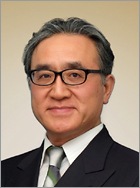Welcome Message
- Welcome Message
- Details: Program, Registration fees…etc.(PDF)
- Entrance for Online Registration
The 2014 Annual Meeting of Japan Society for Bioscience, Biotechnology and Agrochemistry
HARUHIKO MASAKI

Please allow me to say a few words leading up to the 2014 Annual Meeting of the Japan Society for Bioscience, Biotechnology, and Agrochemistry.
As the meeting literature states, our 2011 Annual Meeting scheduled to be held in Kyoto was postponed one year, to 2012, due to the occurrence of the Tohoku Earthquake just before the event; and our 2013 Meeting was held in Sendai as a gesture toward the recovery efforts in Tohoku.
For the first time in four years, Tokyo will be the host of the 2014 Meeting at the Keio Plaza Hotel in Shinjuku, on Thursday, March 27, and at Meiji University’s Ikuta Campus in Kawasaki city, from Friday, March 28 to Sunday, March 30.
Since 2012, we have held our General Meeting separate from the Annual Meeting, as opposed to holding it on the first day of the event. Now the Annual Meeting’s first day is dedicated to awards ceremonies for each award category, lectures related to the awards, and a social gathering. Taking into account the positive feedback from the last two years regarding the hosting locations, we have decided this year to hold these events in the same place (the Keio Plaza Hotel).
The general talks and symposia held from the Meeting’s 2nd day (March 28th) will be at Meiji University, thanks to the kind cooperation of that school’s Agriculture faculty and Science and Technology faculty. The exact site will be Meiji’s Ikuta Campus, which, blessed with abundant natural greenery, should be in impressive form given the season. The campus also has favourable access from Shinjuku and Shibuya. We have scheduled a mixer for all participants on the evening of the 29th in hopes that the venue will serve as a fine location for the exchange of new scientific discourse.
In my opinion, it is a distinguishing feature of biology compared to physics that living organisms develop not a unique solution but a variety of solutions in spite of each elementary process following the principles of physics. Here is the origin of biological diversity and biological substance diversity, creating multifarious research subjects, to which bioscience, biotechnology, and agrochemistry offer a head-on approach. The general presentations at our Annual Meeting each year also exhibit a diversity that is a real treasure. This year’s Meeting will be similar, with symposia organized on 29 diverse themes scheduled primarily on the afternoon of the final day.
Bioscience, biotechnology, and agrochemistry address a multitude of social and lifestyle needs. On March 29, we will hold the forum and mixer of the academic exchange committee between government, industry and academia. The lunch hour on each day of the Annual Meeting will be dedicated to various luncheon seminars planned with the assistance of several businesses and organizations, and will include the JABEE luncheon symposium as well as a symposium regarding gender equality. The latter, organized by JSBBA, marks the first occasion to have a gender equality symposium.
Also, the Nougeikagaku Meeting for High-school Students on March 28 will be marking its 9th year as ones held in our Annual Meetings. Bioscience, biotechnology, and agrochemistry are not included as specific subjects in high school curricula, but I suppose our Society is best suited to offer fruitful topics of study to real world biology and chemistry. I think now is an opportune time to deepen discussion of how our disciplines can contribute to future education, particularly since we have included a new member category for educators.
Note also that the Annual Meeting dovetails with the affiliated Frontier Symposium in Moriya (Ibaraki prefecture), to which we can travel by bus on March 30, and which continues until the 31st (the venue is the Duplex Seminar Hotel).
Traditionally, our Society has emphasized educational activities, with nearly all of the annual meetings being based on oral presentations. We moved from using 35 mm slides to overhead projectors, then to the introduction of PC-based presentations at our Kyoto Meeting. Although during the Sendai Meeting overhead cameras were utilized, we plan to follow on from the Kyoto Meeting with PC/LCD projectors in 2014, given on-going technological trends and the qualitative and quantitative benefits with regard to information communication. The large-scale size of the Meeting requires a specific response to facilitate smooth presentations and we hope this new format will take hold with both the JSBBA event managers and participants.
We have also made arrangements for a more convenient system for event registration and payment of membership fees/event fees as we continue to enhance our on-going efforts toward an Internet-based system. Even after the noon February 10 pre-registration deadline for discounted event fees has passed, we still encourage participants to complete online registration before the day of the event.
Lastly, I would like to extend my sincere gratitude to the many businesses and organizations that have donated funds or will contribute exhibits, participate in luncheon seminars, or display advertisements during the Meeting. It is my ardent hope that the four days of the gathering will be a rewarding occasion for all of us to gain new information, communicate new information, make new acquaintances, engage in lively discussion, and renew old friendships.





